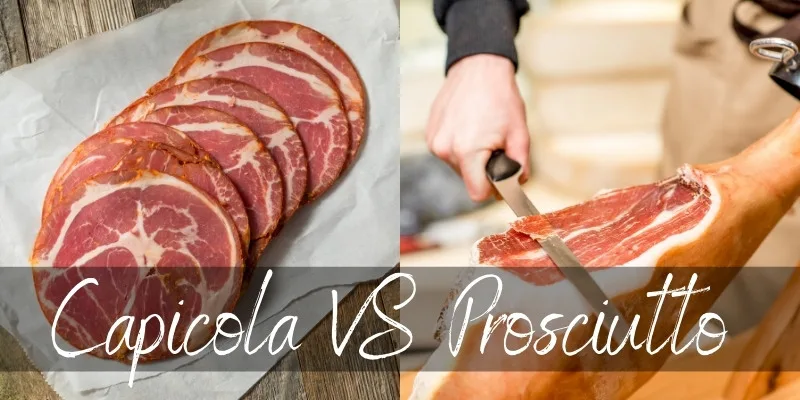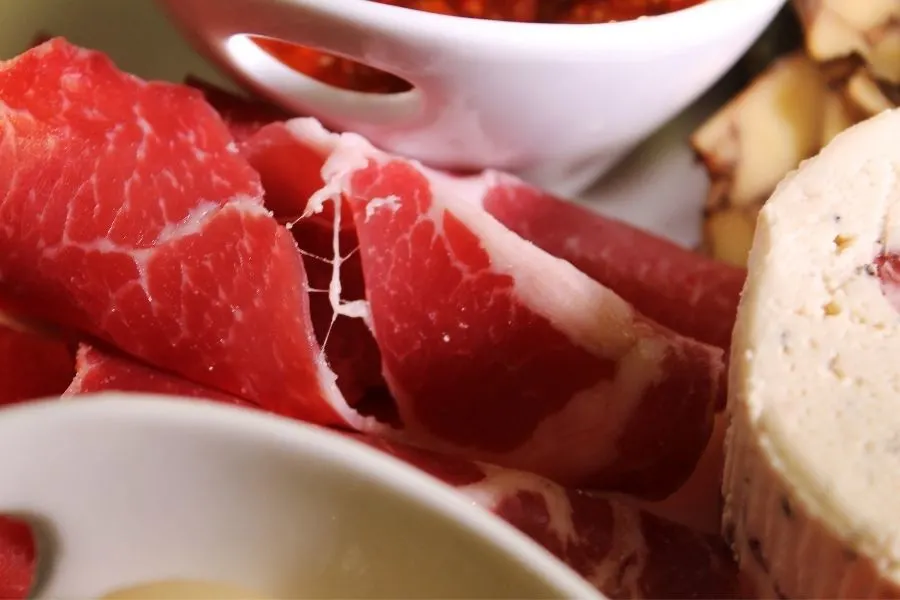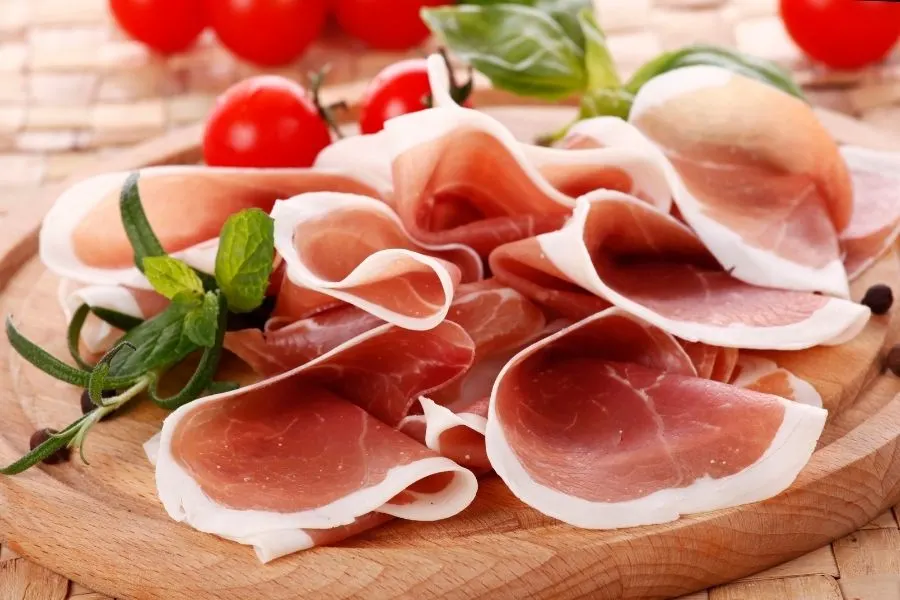Who doesn’t enjoy thinly sliced cured meat with a chilled beer or wine? Everyone has tried the flavorful cured salamis on the charcuterie boards, which often include prosciutto.
However, due to their close resemblance, many people tend to get confused between capicola and prosciutto. Some even think that they are the same, which is wrong. If you’re one of those confused souls, we got you covered!
In this article, we’ve written an in-depth article regarding capicola vs prosciutto. By the end of this post, you will never get confused between the two delicious cured meats in your life.

Capicola VS prosciutto
Capicola and prosciutto are both cured meats made from pork, but prosciutto is made from the hindquarters of the pig. Capicola is made from the neck or shoulders, generally from the coppa muscle.
Prosciutto is a smoked and aged meat, and takes up to 24 months to mature. Capicola can be ready within 6 months, and is packaged differently.
Where prosciutto is wrapped in pig fat and skin (the entire leg), capicola comes in a casing like salami, and there’s a difference in flavor as well.
Capicola may have several seasonings, aside from salt and may include paprika. Prosciutto is always salt and nothing else.
These are the main differences, and we’ll discuss each of them and more in detail below. However we think that to really understand these differences, we also have to touch on what each of these meats is. So we’ll start with that.
What is capicola?
Capicola is a traditional dry-cured, cold cut meat of Italian origin. It is a whole muscle meat which is dry-cured for months and is served in extremely thin slices. It is very flavorful and melts in your mouth.

This salume is also known as Coppa or Capocollo in some regions of Corsica and Italy. The term Capocollo originated from two words, “capo” meaning head and “collo”, or “neck”, which signifies the location of meat.
Where is capicola or coppa located?
Capicola is obtained from the muscle that starts from the neck or the fourth (or sometimes fifth) rib or pork neck or shoulder. This gives it a more tender texture, but it’s also useful just to tell the meat cuts apart.
What is prosciutto?
Prosciutto is another popular dry cured meat of Italian origin. It is one of the most popular cured meats in the world. It is also served raw and thinly sliced. Because it is an extremely fatty cut, it melts in your mouth and gives a nice buttery texture.
You may also find cooked prosciutto, though that will always be labeled as ‘prosciutto cotto’, meaning ‘cooked ham’. Unless otherwise specified prosciutto is always a cured, aged meat.
And yes, you can eat raw prosciutto as much as you like. Due to the high salt content and aging process, any bacteria or mold that may grow on the meat is long gone, despite starting out as raw.

Where is prosciutto located?
Prosciutto is obtained from the thigh or hind leg of a healthy pig. It is cleaned and then covered with salt and left for two months in a cool environment. After two months, it is taken out, washed and then aged again for 18 months or so.
Lots of salt is used in the curing of this meat, and it may also be smoked. Curing prosciutto is an artform, and the butcher in charge of the operation needs to be very careful to provide airflow for those 24 months. In short, prosciutto is more work than capicola, and it shows in the final flavor.
Read also: 3 Differences Between Prosciutto, Pancetta, And Bacon
Are capicola and prosciutto the same thing?
Some people believe that all kinds of cured meats are known as prosciutto. However, this is wrong. Different types of dry-cured meats are different from each other in many ways.
So, prosciutto and capicola are two different types of dry salumis. They are different with respect to their cut location, size, production, flavor, texture, appearance and so on.
By salumi, we mean the old word used for salted, dried meat. It’s where the word for salami was derived from, actually.
Let’s discuss the differences between prosciutto and capicola in detail, so you’ll never confuse them again.
Capicola comes from the neck, prosciutto from the hindquarters
Generally, capicola or coppa is obtained from a muscle that runs from the neck of a pig to the fifth or fourth rib of its shoulder or neck.
On the other hand, Prosciutto is obtained from the thigh or hind leg of a pig. Moreover, it is the same cut that is used for preparing hams.
Capicola is always pork, prosciutto may be other animals
As a rule of thumb, capicola is always made from the pig’s meat. Specifically, the muscle meat of the animal. It is never made using the meat of another animal.
On the contrary, prosciutto can be made with meat from other animals as well, such as cow, lamb, goat, or another domestic animal. The most common animal used is the pig, and unless it states something else on the label, it’s always pork meat.
However you may still find beef prosciutto, or lamb prosciutto, or another such version. They’re not common, you don’t be surprised when you do find them.
Capicola is always smaller than prosciutto
When you’re looking at the whole cut of meat, you’ll notice that capicola is reasonably sized, while prosciutto is a large cut of meat. In fact, prosciutto is the entire leg of the pig, hung to dry and age on hooks.
You can even find the entire prosciutto leg for sale, and it comes at a steep price.
Capicola is always cheaper than prosciutto
Capicola is cheaper than prosciutto because it is smaller in size and doesn’t take too long to get ready. Prosciutto on the other hand takes about two years for production and thus, it is twice as much as the cost of capicola.

Differences in taste and texture
Prosciutto has a higher concentration of fat. The slice has more fat at the edges, and may be tough. So, sometimes you strip the fat and end up chewing on it solely.
On the other hand, capicola has a uniform distribution of fat and hence, it is more neatly sliced and looks beautiful as well.
Coming to the flavor, both meats taste great and have a buttery texture. Everyone has different views on the flavors of two cured meats. While some folks enjoy the flavor of capicola, others go for prosciutto.
Read Also:How Long Does Prosciutto Last ?
Differences in how capicola and prosciutto are made
As we already discussed, prosciutto is made from the thigh or hind leg of a pig. The leg is cleaned and prepared first and then kept covered in salt for two months at a cool temperature.
The salting process removes the blood, moisture and the bacteria from the meat. Once this process is done, meat is taken out and washed to get rid of all the salt. Finally, it is again left for ageing for at least 18 months.
This is a long process and the butcher needs to provide plenty of airflow. If not, moisture may develop in the storage room and bacteria will return. The end goal is for the meat to be dried out so it will keep for a long time.
On the other hand, capicola is obtained from the neck of the animal. It is cleaned, rolled tightly and tied using a twine. Next, it is covered nicely with the curing mixture and sealed using a vacuum packer. Once sealed, it is left in the refrigerator for a minimum of 7 to 8 days.
After a week, the meat is removed from the fridge, washed under running water and dried completely. Finally, it is placed on a rack at 55-65 F for about 5 to 6 weeks for curing.
As you can see, prosciutto takes longer to get on the plate while capicola gets ready in just 1 and a half months.

